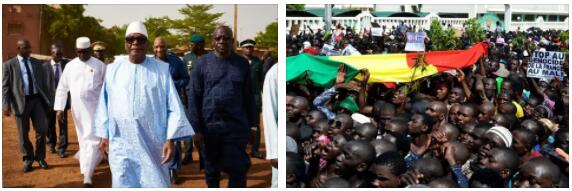State structure and political system of Mali
In accordance with the 1992 Constitution, Mali is a republic. The head of state and supreme commander of the armed forces is the president. The President is elected by direct universal suffrage for a term of 5 years and may be re-elected for another term. Legislative power is exercised by a unicameral parliament – the National Assembly (147 deputies elected by direct universal suffrage for 5 years). Executive power is exercised by the president and the government. The president appoints the prime minister, who forms the government. Check cancermatters for political system of Mali.
Administratively, the country is divided into the Bamako region and 8 regions. The largest cities are Bamako, Segou (132.4 thousand), Mopti (114.4 thousand), Sikasso (125.4 thousand), Gao (105 thousand).
Until 1990, there was a one-party system in Mali, the leading role in the political life of the country in 1960-68 was played by the Sudanese Union-Democratic Rallying of Africa (SS-DOA) party, in 1979-90 by the Democratic Union of the Malian People (DMN), and during the military regime (1968-79) political parties were banned. The legalization of opposition parties to the regime refers to con. 1990.
In 2002, 72 political parties were registered in Mali, united in blocs, coalitions and alliances. 47 parties had real political weight, and 4 parties are represented in the highest bodies of power: ADEMA, NKDI (National Congress of Democratic Initiative), SS-DOA and PDO (Patriotic Movement for Renewal). ADEMA – Pan-African Party for Freedom, Solidarity and Justice, established in 1990; Malian Party for Development and Revival established in 1991; NKDI was established in 1991; United for Democracy and Progress (1991); United for Democracy and Labor (1991); Party for Democracy and Progress (1991); Union of Democratic Forces for Progress (1991); Union for Democracy and Development (1991); The Sudanese Union – Democratic Unification of Africa was created in 1946, banned in 1968, legalized in 1992.
The trade union movement in the country is headed by the National Union of Workers of Mali, founded in 1963, which includes 12 branch trade unions.
The armed forces of Mali are 7350 people: ground forces – 6900, navy – 50, air force – 400. In addition, the gendarmerie – 1800 people, the republican guard – 2000 people, the police – 1000 people.
Mali has diplomatic relations with the Russian Federation (established with the USSR on October 14, 1960).
Economy of Mali
GDP $2.75 billion, or $230 per capita (2002). The average annual GDP growth in 2000–02 was 2.8%. GDP structure: agriculture 45%, industry 17%, services 38%. The economically active population is 3.93 million people: 70% are employed in agriculture, 15% in the service sector, 15% in industry and trade. Agriculture is the backbone of Mali’s economy. Characterized by low rates of development due to the persistence of traditional socio-economic relations, archaic methods of farming. Cultivated (2000, thousand tons): millet (953), sorghum (714), corn (437.5), wheat (33), rice (727 – 1st place in production in West Africa), yams and sweet potatoes ( 10-15), cassava (150-200), beans, fruits and vegetables; peanuts, cotton (460-500), sugarcane, tea, tobacco, kenaf (2). The average catch of fish is 90-100 thousand tons per year. Mali is one of the leading pastoral countries in West Africa. Livestock (thousand): cattle – 6000, sheep – 5950, goats – 8550, horses – 136, donkeys – 652, camels – 369, pigs – 65.
The industry is focused on the processing of agricultural raw materials and the creation of import-substituting industries (food, light, textile, leather, chemical, electromechanical and other industries), as well as the development of mineral resources (gold mining – up to 45 tons, diamonds, phosphates, limestone, marble, stone salt – 3-3.5 thousand tons).
The transport network includes 729 km of railways and 15,100 km of roads (1827 km of paved), 1815 km of waterways and 27 airports (7 modern class).
The country pursues a policy aimed at the liberalization of the economy, the transition to market relations. The tasks of self-sufficiency in food, increasing the competitiveness of the export sector of the economy are set.
State budget (2002, million USD): revenues 764, expenditures 828.
External debt of 1.4 billion dollars, deductions on account of its repayment of 8.8% of the country’s export earnings (2001).
The unemployed are 14.6% of the urban and 5.3% of the rural population. 64% of the population lives below the poverty line: 30% of the urban and 76% of the rural population.
Foreign trade turnover (million US dollars) 1175: export 575 (cotton – 43%, gold – 40%, livestock); imports 600 (machinery and equipment, building materials, petroleum products, foodstuffs, textiles). Main trading partners: in terms of exports – Brazil (10.6%), South Korea (9.9%), Italy (7.3%), Canada (7%); imports – Côte d’Ivoire (21%), France (12.4%), Senegal (4%), Germany (4%), Benelux countries.
Science and culture of Mali
Mali introduced free compulsory nine-year education. In 2001, there were 3562 primary schools in the country, where 18.3 thousand teachers taught. The State University operates in the higher education system, which unites 5 higher schools (Pedagogical Institute, National Administrative School, National School of Engineering, National School of Medicine and Pharmacology, Training Center for the Telecommunications Society of Mali), 4 faculties (Philology, Arts and Humanities; Science and engineering; medicine, pharmacology and dentistry; legal and economic sciences) and research institutes (Institute of Fundamental Sciences and Applied Research, Agricultural Polytechnic Institute, University Institute of Management, Institute of Technology).
The National Library of Mali was established in 1913; its holdings contain approx. 20 thousand volumes. Literary creativity is represented by such names as A.A.Ba, F.D.Sissoko, S.Badian, S.Dembele, J.Uologem, J.Diakte, S.Bokuma, P.B.Kulubali, M.M.Diabate.
